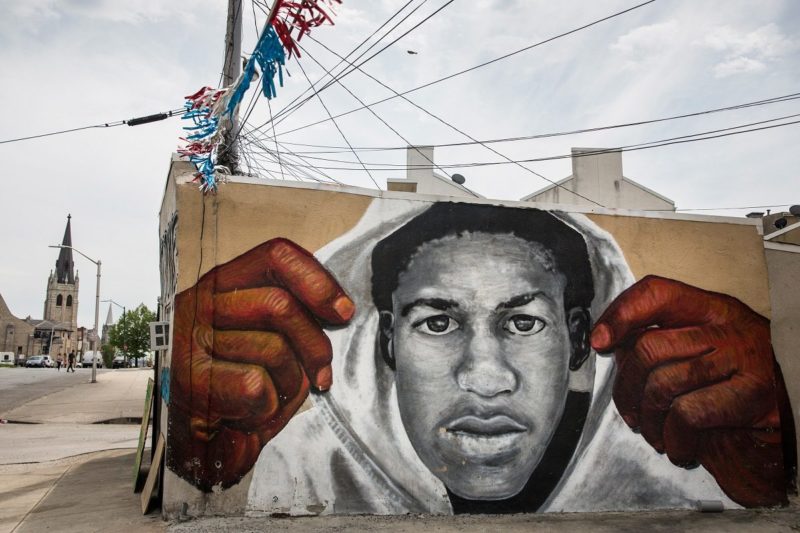Black Lives Matter Network Marks Four Years With New Report
"We work to manifest a world where Black people are not constantly fighting to survive, but can thrive in safe and sustainable environments."

The fatal shooting of 17-year-old Trayvon Martin and the subsequent acquittal of George Zimmerman in 2013 gave rise to the Black Lives Matter movement—”a call to action in response to state-sanctioned violence and anti-Black racism,” explains a new report marking its four-year anniversary.
“Our intention from the very beginning was to connect Black people from all over the world who have a shared desire for justice to act together in their communities. The impetus for that commitment was, and still is, the rampant and deliberate violence inflicted on us by the state,” said BLM co-founder Patrisse Khan-Cullors on the companion Celebrate BLM website. Khan-Cullors co-founded #BlackLivesMatter with organizers Alicia Garza and Opal Tometi.
Since the Black Life Matters Ride to Ferguson, Missouri, in 2014, after officer Darren Wilson shot and killed 18-year-old Michael Brown, the movement has expanded to a global network of more than 40 chapters, with a mission “to build local power and to intervene in violence inflicted on Black communities by the state and vigilantes.”
The 55-page report highlights the BLM global network’s guiding principles, challenges, and plans for the future, along with a snapshot of where its member organizations have been.
Within the past year, BLM activists and Movement for Black Lives organizations have bailed out Black mothers and fathers; reclaimed “40 acres in 40 cities” to mark Juneteenth, the annual commemoration observing the announcement of slavey’s abolition in Texas; highlighted the urgency of improving Black health; examined the state of Black women in the United States; marched for living wages, immigrant rights, and trans women, among other causes; and stood in solidarity with tribal leaders at Standing Rock opposed to the Dakota Access pipeline.
BLM in Toronto shut down the 2016 Pride march in an effort to recenter “Black queer and trans experiences in movement history”; organizers in Birmingham were joined by immigrant rights advocates in their successful fight for “sanctuary city” status; Los Angeles network members occupied the police headquarters for 40 days, demanding the city fire Police Chief Charlie Beck; and in Minneapolis, organizers uncovered video footage of Jamar Clark that contradicted the police narrative of the 24-year-old’s fatal shooting.
“Revolutionary resistance is culture shock to both white and Black folks. Much like folks across the country, we find ourselves in these intersections and centering those who are most impacted,” notes the Cleveland chapter in the report. “We are the memory for Black people, which is powerful in a place like Cleveland.”
Tanisha Anderson and Tamir Rice’s stories may be well known, but the story of homeless Timothy Russell and Melissa Williams, who were shot at 137 times by Cleveland police officers in 2012, is not.
Evelyn of BLM Urbana-Champaign said organizers are still trying to figure out what to do and how. While there are many activist organizations on her campus, there are none focused on or led by Black people.
Elsewhere, the Nashville chapter organizes “because before we can talk about liberation, we have to talk about survival.”
The report comes at a time when the current presidential administration seems more focused on ramping up protections of law enforcement than addressing the demands of those uprising against anti-Blackness and state violence.
“We have made these strides amid challenging times. We face blatant anti-Blackness, capitalist values, and imperial projects. While Blackness and the Black experience are not a monolith, the fact of our material conditions cannot be ignored or erased,” said Nikita Mitchell, organizing director of BLM Bay Area, in the report.
The report calls on supporters to donate or participate in local efforts, organize an action, and become an ambassador by pushing back on false narratives about Black Lives Matter and its work.
The mandate is to “organize and end all state-sanctioned violence until all Black Lives Matter,” wrote the network’s communications director Shanelle Matthews and BLM Minneapolis communications strategist Miski Noor, the authors of the report.
“Our dissent, demonstrations, demands, and tireless fight for dignity have revealed a ubiquitous white rage, resentment, and revenge. Coupled with economic insecurity and a rise in global conservatism, we are living in a more precarious political landscape than we were just one presidential election ago.”
Which is why BLM is needed now more than ever, said Khan-Cullors.
“Our struggle calls for the liberation of Black people. This means we continually fight against the denigration of our human rights and our dignity as Black people. In four years, we have built a Black queer, women, and youth-led movement. However, we have many more struggles to overcome and victories to win. We work to manifest a world where Black people are not constantly fighting to survive, but can thrive in safe and sustainable environments.”
“Four years later, we still declare with conviction that Black Lives Matter everywhere,” said Khan-Cullors.
